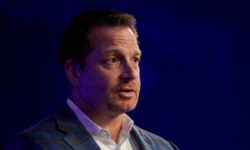Aurora is finally ready to show the world what it’s been up to
The secretive self-driving car company unveiled its plans for 2020
/cdn.vox-cdn.com/uploads/chorus_image/image/66162368/Pacifica_High_Res__1_.0.jpg)
Aurora, the self-driving car company founded by former Waymo engineer Chris Urmson, doesn’t do dog and pony shows. It doesn’t trot out its vehicles just to prove they exist or take journalists for test drives to demonstrate that the technology actually works. In fact, in the three years since Aurora launched, the public has heard very little about how Aurora plans to compete against Waymo, Ford, and General Motors.
After months of announcements — the company acquired a LIDAR sensor maker, hired a VP of hardware, and took an investment from Amazon — that finally appears to be changing. Just before the New Year, Urmson’s co-founders Sterling Anderson and Drew Bagnell hosted a rare media event to talk about their technology and take journalists for test drives. It was, in other words, a dog and pony show.
These vehicles look like garbage because they’re test vehicles, Anderson said, before ushering us outside to try them out. The vehicles, a fleet of Lincoln MKZs, did not look like garbage; they looked functional and exceedingly clean. Inside, screens mounted on the backs of the front seats displayed a dynamic map with moving blocks and blinking lights. It was the world around us, interpreted through the eyes of the car.
It’s the main line of our software, Urmson tells me in a phone call the following week. (He missed the event because of a cold.) It wasn’t some kind of weird, pulled off to the side, polished for demo. It was our core developer branch.
It was this software that powered me along at about 20 miles per hour, accompanied by two of Aurora’s safety drivers and a journalist from NPR. As we pulled away from the venue, an oncoming vehicle nudged into our lane, prompting Aurora’s car to brake abruptly. The safety drivers seemed unperturbed. While their hands stayed on the wheel, they were observing the car in a relaxed manner, and they didn’t seem to need to take control. After successfully completing multiple left-hand turns near distracted pedestrians — the gold standard, I am told, for autonomous vehicles — the car seemed to recover its dignity, depositing us back at the venue without incident.
To date, Aurora has raised $690 million in funding, and Urmson has been hailed as the Henry Ford of autonomous vehicles, thanks to his work helping to pioneer Google’s self-driving car initiative. His co-founders have equally prestigious backgrounds: Sterling Anderson helped lead Tesla’s Model X project, while Bagnell ran a research lab at Carnegie Mellon then left to work on autonomous vehicles at Uber.
The result has been a team and company that self-driving car enthusiasts are eager to hear from. Yet, in an industry characterized by lofty predictions and flashy demonstrations, Urmson has been a voice of restraint and reason, particularly over the last couple of years.
Over the next five years, we’ll start to see commercial fleets of autonomous vehicles piloting people and goods.
Back in 2015, Urmson said that his goal for autonomous vehicles was that things would progress so rapidly that his 11-year old son would not need to get a driver’s license. Now, he has a more measured prediction: over the next five years, we’ll start to see commercial fleets of autonomous vehicles piloting people and goods. After that, we could start to see broad adoption.
Waymo, for its part, has been testing autonomous vehicles in Phoenix since 2017. In 2018, the company launched a limited ride-hailing service using its self-driving cars. The program is available in the neighboring towns of Chandler, Gilbert, Mesa, and Tempe in Arizona. More recently, it began offering rides to people in its fully driverless vehicles without safety drivers.
Urmson, whose son just turned 16 and is finally in the process of getting his driver’s license, says that his original goal isn’t actually that far-fetched, given these rapid developments. In my defense, if we happened to have moved to Chandler, there’s a neighborhood where he could conceivably get a ride around in a self-driving car without having to drive, he said.
Aurora’s core product is called the Aurora Driver, a combination of software and hardware that can be installed in different types of cars to make them drive autonomously. (This echoes his old employers who call their product the Waymo Driver.) So far, the system has been integrated into six different types of vehicles, including sedans, SUVs, minivans, commercial vans, and Class 8 freight trucks — none of which have been deployed commercially.
Notably, these developments won’t mean Aurora will spend a lot more time test-driving cars. We’re going to drive about half as many miles this year, Sterling said at the event, adding that the company is focused on testing the vehicles in simulated environments. That strategy allows Aurora to test the car in unique situations that rarely come up in the real world: a fallen tree blocking the road, for example, or a severe car crash obstructing traffic. As the car learns how to respond to those situations in a simulated environment, it gets better at reacting on the road.
These developments won’t mean Aurora will spend a lot more time test-driving cars

To that end, Aurora has developed a proprietary system for executing these types of test drives, ultimately increasing simulating driving experiences by a factor of 100, as reported by Automotive News. It’s also doubling down on a teleoperation program that will allow specialists to remotely monitor the cars through its cameras and provide assistance in a pinch.
When Aurora does test-drive cars this next year, it’ll likely be the specially designed Chrysler Pacifica minivans — a model that is also used by Urmson’s old employer Waymo. The company recently announced that it’ll begin driving these vehicles in complex urban environments using the latest version of the Aurora Driver and an updated version of its LIDAR.
The company also said that it plans to integrate the Aurora Driver with a tractor-trailer, thanks to this new LIDAR sensor. Previously, they said, a sensor necessary for safe freeway driving for trucks did not exist. Now, happily, it does, and the company plans to use it to quickly move forward in trucking.
Self-driving technology is expensive and time-consuming to develop, which is why many of Aurora’s competitors are owned by or aligned with big auto manufacturers and tech companies. Aurora, in contrast, plans to stay an independent supplier. To have the biggest impact, we’ll work across a bunch of different automotive companies and truck companies and support their businesses, Urmson says. Whether they are public transit agencies or the Ubers and Lyfts of the world or logistics companies like Amazon or FedEx or UPS. We think about building a driver that can support all of those opportunities.
Whether the company will be able to do that without a buyout from Big Auto is an open question. But Urmson seems confident that it will happen. It’s the kind of technology that captures peoples’ imaginations, he says, adding that he doesn’t plan to make media events a regular occurrence. We would much rather spend the time building something we’re proud of and then see that impact the world than spend a whole lot of time on superficial demonstrations.




